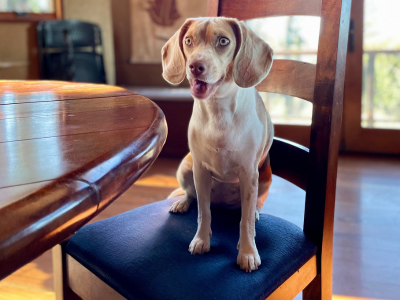BACKGROUND CHECK
CU data scientists find flaws with dog DNA-testing companies
By Kara Mason
October 2023
Lila is a registered purebred beagle. But depending on which company does her DNA testing, she might be part rottweiler, part American foxhound, or not a beagle at all.
A study by researchers in the Department of Biomedical Informatics (DBMI) at the University of Colorado School of Medicine revealed that some dog DNA testing companies may rely less on genetics than on a photograph of the dog provided by the customer.
To conduct the study, the researchers selected six direct-to-consumer (DTC) dog DNA testing companies. In Lila’s case one of those companies concluded that Lila was 50% poodle, 50% bichon frisé, and 0% beagle.
“I was at a meeting where we were talking about the reliability of direct-to-consumer genetics tests, and we hatched this plan to investigate dog breed tests,” says DBMI founding chair Casey Greene, PhD. “Somebody said that these testing
companies have you upload a photo of your dog and I thought, ‘Are they actually doing a DNA test at all?’ That’s when we decided to figure it out.”

For some dog DNA tests, companies require pet owners to upload a photograph of the pet with the DNA sample. In other tests the photo can be optional. This photo of Lila, a purebred beagle, accompanied her cheek swab. Photo courtesy of Monica Munoz Torres, PhD, associate professor of biomedical informatics.
FETCHING RESULTS
The study, which began in late 2021, recruited 12 dogs of different breeds from across the country. Each dog was registered or eligible for registration with a breed organization to ensure its status as purebred.
Cheek swabs were taken from each dog and sent to six different DNA-testing companies that claim to test canine DNA to determine breed.
For half the tests, the sample was sent with an accurate photo of the DNA donor, but for the other half, the sample was submitted with a photo of a different dog, one that was genetically and physically much different.
“In one swap, we paired a photo of a Brittany spaniel, which is a big, silky-haired dog, with a Chinese crested, which is a small, hairless dog,” Rando says. “We made sure that there was no chance that the two dogs would get conflated by the nature of being closely related.”
In the case of the Chinese crested dog, five of the six companies reported results that included a photo of the spaniel came back mostly accurate. But one test, completed by Accu-Metrics, determined in an “official analysis” that the dog was part border collie and part golden retriever — a conclusion that seems to align more with the photo that was submitted rather than with the DNA sample.
Researchers say that the DNA-testing companies should be able to conduct accurate genetic testing without a photograph of the dog.
“In most cases, at least one test provided a breed prediction that did not match the registered breed,” researchers write in their findings. “Because our analysis focused on evaluating whether the reported ancestry deviated from the expected ancestry, which in purebreds is 100% of a single breed, minor differences in how results were reported by different companies did not affect our analyses.”

Halie Rando, PhD, led the study of dog DNA tests while she was a post-doctoral student in the Casey Greene, PhD, laboratory.
Variances in testing mechanisms, or the markers used in testing, might explain why some tests reported Lila to be 100% beagle and others reported her to be 90% beagle. It doesn’t explain why one test would report she’s not a beagle at all.
“Even among our team of people well-versed in genetics, it can be difficult to understand these small differences, what’s spurious, and what’s meaningful,” Rando says. “It’s a really challenging environment to navigate even with significant genetic literacy.”
BREED BANS
Inaccurate DNA testing can sometimes have significant consequences for pet owners.
Controversial breed-specific legislation started gaining popularity more than four decades ago, when some cities outlawed people from owning certain breeds, such as “pit bulls” and rottweilers. Insurers and property-leasing companies have used breed lists to deny coverage and housing to people owning specific dog breeds.
“One of our concerns was that some of these tests can have real financial implications for a person’s ability to rent, get insurance, or live in a particular city without compelling evidence that it is a valid result,” Greene says.
In the CU study, a company called DNA My Dog identified a bulldog as a wolf hybrid; it also determined that Lila the beagle was a rottweiler. Accu-Metrics identified a German shorthaired pointer and a golden retriever as having ancestry that would qualify them as part pit bull.
“None of these ancestry predictions were supported by any other DTC tests. Therefore, it would be possible for dog owners to face severe financial repercussions in terms of home insurance and even housing rental eligibility if they view the results of a DTC test as definitive and self-report a dangerous breed, or if DTC canine genetic testing were adopted for housing and insurance purposes,” the researchers say.

Casey Greene, PhD
While the researchers didn’t investigate the health or trait analysis that some of the companies offered in the DNA testing, they say they’re an added cause for concern for pet owners and veterinarians.
Ancestry conclusions from Accu-Metrics were more often at odds with many of the dogs’ pedigree registration, even for the 10 American Kennel Club-registered dogs, which requires dogs to meet strict breeding standards over many generations.
“Genetic information can contribute to pet owners’ decisions regarding their pets’ health, and when this information is incorrect or is being interpreted incorrectly, it can lead to tragedy,” the researchers say.
Rando and Greene say dog owners should be cautious about dog DNA testing and the companies that offer those services.
“Not all tests are created equal,” Greene says. “It is important the services are evaluated independently with careful experimental designs to understand their strengths and weaknesses. That’s part of what we contribute as scientists.”